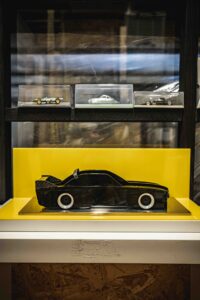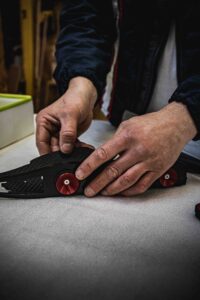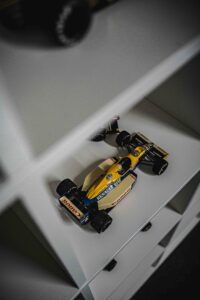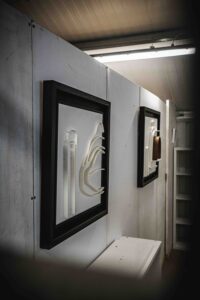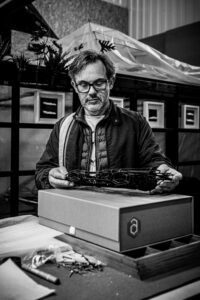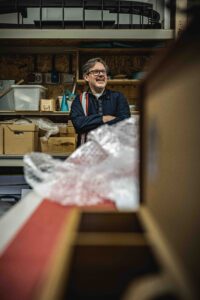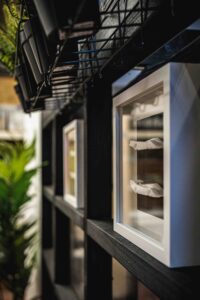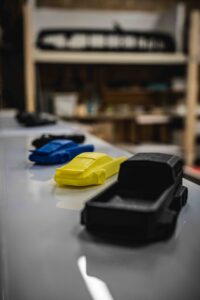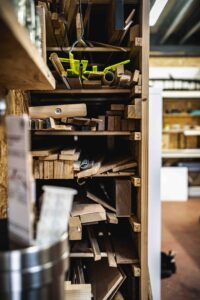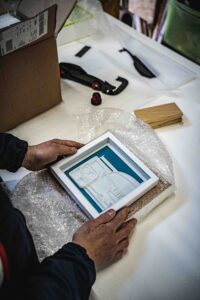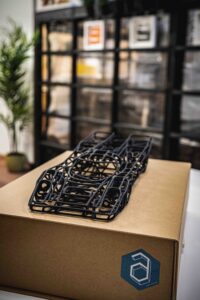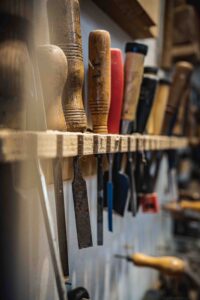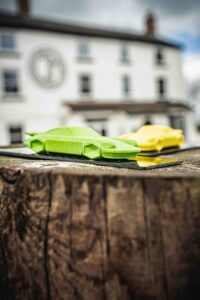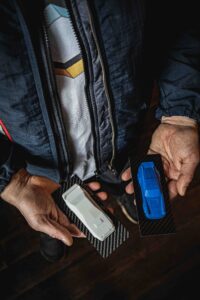After a successful career in video game design, C&M Emporium-featured artist Jonny Ambrose went all-in on his passion project in 2016: gorgeously minimalist sculptures inspired by the automotive form. We chatted to Jonny to find out the driving forces behind his work.
Strip away the details, the intricacies, the stylistic creases and flourishes on a car’s body, and you’re left with its profile, its raw form. Arguably, the most successful, enduring designs are recognisable by these. Think of the steep rise and gentle fall of the roofline of a Porsche 911, the starkly angular, pointy wedge shape cut by a Lamborghini Countach, or the brutalist aerodynamic forms of a ‘Batmobile’ BMW 3.0 CSL. All would be instantly recognisable to car fans even when presented with a simple side profile, shorn of any further identifying details.
How do you take these 2D silhouettes, and return them to a 3D plane without corrupting their purity? This is one of the questions tackled by the work of automotive artist and sculptor Jonny Ambrose. “It’s not just the cars [that inspire me],” says Jonny. “I love architecture, I love design. The cars are one element, then it’s looking to the real world, looking at materials where you think ‘it’d be really interesting to try and portray a car using these materials, in this particular way’. Because I’m working in 3D, the play of the light and how it falls on an object is interesting to me. That kind of dictates how I portray a car’s form.” The resulting striking sculptural interpretations of automotive shapes that Jonny crafts in his workshop-stroke-garage, tucked away in a quiet corner of Warwickshire, have earned him international recognition and acclaim.
While Jonny’s work has always been in visual fields, his sculptural work was, for a long time, on the back burner thanks to a very successful career elsewhere. “In the ’90s, I went to art college in Portsmouth, and then to uni in Nottingham to do sculpture. I did various exhibitions, all on car forms and aerodynamic forms. It was quite hard to make a living just from art, particularly at that stage, so after a few years, I retrained to get into video games.”
Jonny joined development studio Rare and worked on level design for 2000’s Perfect Dark, a highly acclaimed Nintendo 64 title. In 2002, he was part of a group of five to co-found FreeStyleGames (now a studio under the Ubisoft umbrella), which would go on to have major involvement in the massively successful Guitar Hero franchise.
“We worked on some downloadable content for Guitar Hero III and [World Tour]. That was a test of our studio to allow us to do the game that we wanted to do, which was DJ Hero. I was leading a team which was doing the visuals – controlling all the lights, and ensuring everything was playing in time with the music. That was a great challenge, but great fun. We did two iterations of that, and it got rave reviews, but by that point in time the market for music games was being saturated.” This led to the entire franchise and its spin-offs taking an extended hiatus, before Jonny and FreeStyle were brought in to create its return, Guitar Hero Live, in 2015.
Besides the obvious visual thread, how does this career path suddenly veer off into the world of automotive fine art, to which Jonny returned in a full-time capacity in 2016? Well, naturally, he’s a huge car fan, his passion ignited by the raw sensory elements of cars – the visuals and the soundtracks. “As a child of the ’70s, you very infrequently saw motor racing on TV, but when you did, [the cars] were almost like spaceships. They were all extreme shapes, they all had great graphics, and they made great sounds. Those three things really ignited my interest in racing cars, and road cars as well.”
Those early reference points are littered throughout his pieces, from the pops of colour amongst muted palettes to the way some cars have flowing, aerodynamic shapes trailing out behind them, a stationary representation of the visual and aural drama that comes with going very fast.
Jonny’s love for the shapes of the 1970s rears its head again and again in his work. Previous pieces have abstracted the lines of the aforementioned early ‘Periscopo’ Countach, ‘Batmobile’ BMW, and RSR 911. Unsurprisingly, given the way the brand’s air-cooled products seem to be a magnet for artistic types the world over, plenty of other Porsches from the era have inspired his work: the dramatic 917 racer has been the basis for sculptures in both its famous 917K closed-body, short-tail variant and the savage, dominant 917/30 Can-Am racer. The former has been recreated as a staggeringly intricate, half-scale skeletal wire-frame model made from tubular aluminium and carbon fibre.
It’s an era that dominates Jonny’s collection of actual driveable cars, too, which includes a Lamborghini Espada and a Lotus Europa Special. His work is far more decade-spanning, though, drawing inspiration everywhere from the dramatically thrusting art deco shapes of early land speed record cars to the sci-fi forms of Formula E racers.
His processes and materials, too, blend tradition with technology. While wood is a common theme, nothing is off the table, and everything from aluminium to crushed paper has been used. “I always see it as a mixture between more traditional techniques involving the wood, and right up to date processes. I involve a lot of wood that’s steam-bent.” This is a technique that involves exposing wood to the heat and moisture of steam, making it more flexible and allowing it to be shaped into remarkably curvaceous, organic forms. Historically, it’s been used in boat building, furniture manufacturing and all sorts of other industries, but it allows artists like Jonny to create complex, fluid shapes from a material not particularly known for its pliability. “That’s married to elements that I design in CAD [computer-aided design] software, which are either 3D printed or machined.”
One of Jonny’s personal highlights is Spirit Reborn, a skeletal sculpture unveiled in 2023 in collaboration with MG to celebrate 60 years of the MGB. “That was great to work on because it involved a new material for me, which was Richlite.” This is a versatile material made of crushed up paper infused with a hardening resin and pressed into solid blocks. It’s useful in everything from buildings to, appropriately enough, guitar fretboards. And, it would seem, sculptures of British sports cars.
Another favourite is Superleggera, a piece created as a trophy for Octane magazine’s Editor’s Choice award at the 2017 Quail concours. “It was a great honour to do that. It had one single-piece flowing steam-bent form at the top, which was quite involved and required a lot of trials and tribulations. Overcoming all of those and achieving the end result was a highlight.”
Alongside his commissions for big-name brands like this, Jonny’s work has been exhibited worldwide, beginning with his student days. With its celebration of the primeval reactions that an exciting automotive shape can trigger in us, it was a natural fit for the C&M Emporium, and has been a staple of it since day one. Next time you’re in the Yard, you can stop by the Emporium to browse a selection of his pieces.

